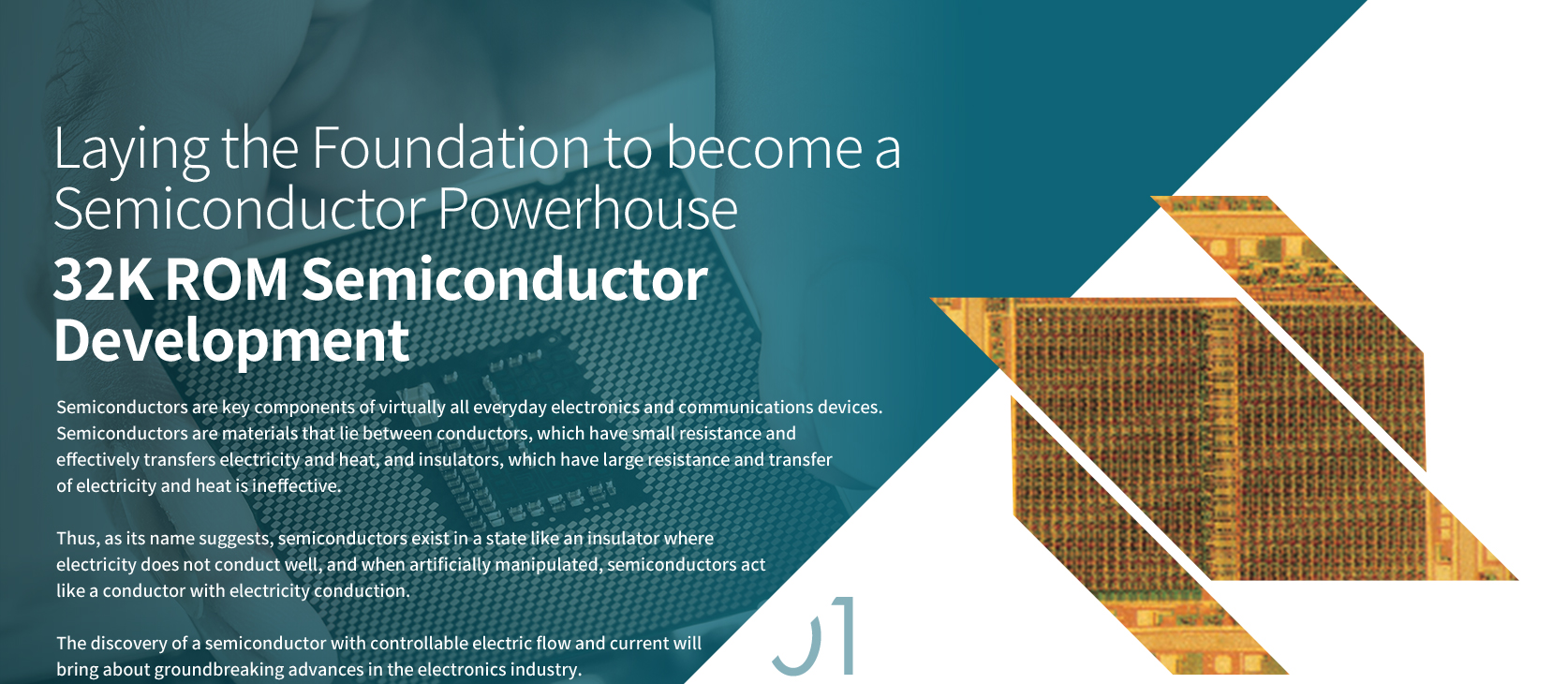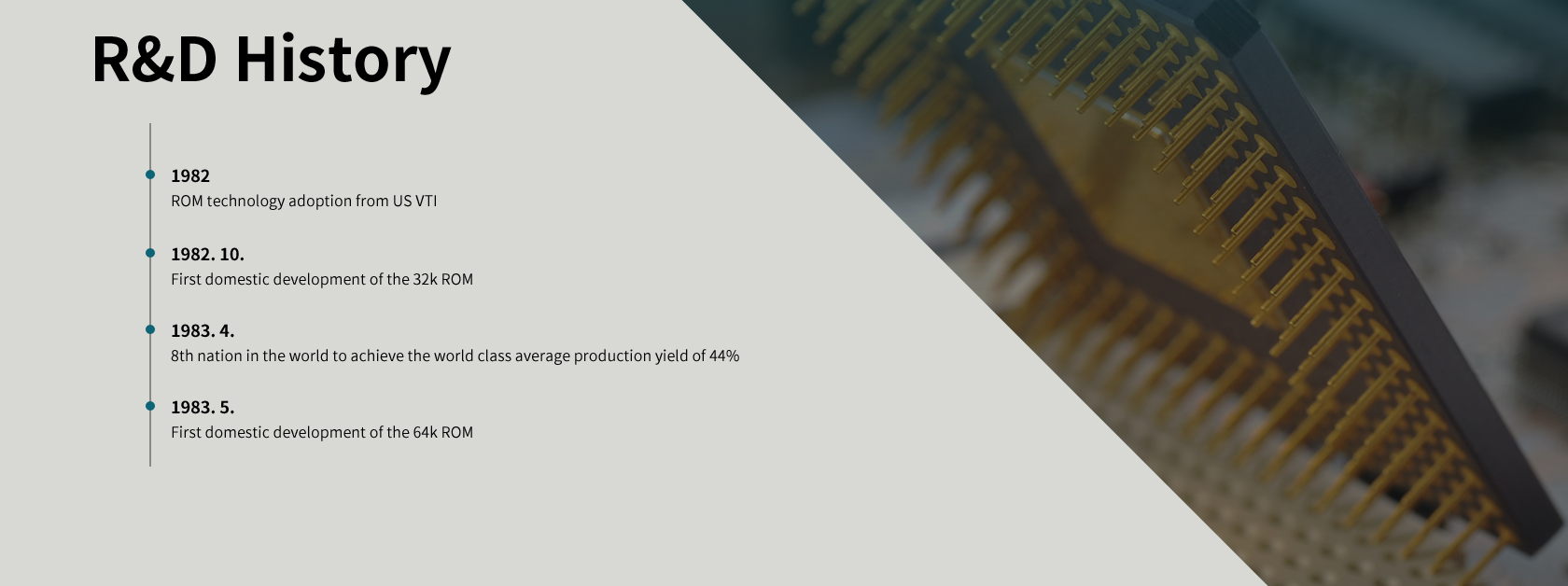






Laying the Foundation to become a
Semiconductor Powerhouse
32K ROM Semiconductor
Development
Semiconductors are key components of virtually all everyday electronics and communications devices. Semiconductors are materials that lie between conductors, which have small resistance and effectively transfers electricity and heat, and insulators, which have large resistance and transfer of electricity and heat is ineffective.
Thus, as its name suggests, semiconductors exist in a state like an insulator where electricity does not conduct well, and when artificially manipulated, semiconductors act like a conductor with electricity conduction.
The discovery of a semiconductor with controllable electric flow and current will bring about groundbreaking advances in the electronics industry. The history of the Korean electronics industry can be said to be parallel to the development history of semiconductors. In this respect, the advancement of semiconductor technology brought about innovations to the electronics industry of Korea and everyday life.
01
Intricate Semiconductor Technology
Reminiscent of a Miniature City
In Korea, interest in the semiconductor industry began in the mid-1970s. Whilst in the middle of contemplating the cultivation of the electronics industry, the Korean government focused on semiconductors as the core technology for the future. At the time, semiconductors were only used as vacuum tube replacements in Korea, and the world turned towards the massive trend of computers. Ultimately, this meant increases in the demand for DRAM and ROM.
At the Economic Ministerial Meeting held in September of 1976, a total of 600 million US dollars covering foreign and domestic capital was committed to 57 product categories and the establishment of 151 factories for the complete domestic development of major products including semiconductors. The Electronics Industry Promotion Plan was adopted in an effort to transform the industry structure to a technology intensive system. In particular, nine product categories related to semiconductors and computers, foreseen to stimulate significant investments and impact, were to be developed led by the government. As a result, the Korea Institute of Electronics Technology (KIET), the former institution of ETRI, was officially established in December 30, 1976.
Located in Gumi, KIET prepared production facilities and prioritized the localization of designs, manufacturing processes, and mass production technologies for semiconductors. Finally, in early 1982, KIET implemented ROM designs and partial processing technology by paying royalties to VTI, US, and succeeded in the first domestic 32k ROM development in October of that year.
The 32k ROM is an integrated circuit with devices that can remember approximately 4,000 words integrated on a semiconductor wafer. The ROM can be widely employed in microcomputers, electronic gaming, industrial robots, and home appliances. The length of the circuitry and device in the 3㎜×4㎜ 32k ROM utilized technology that required an intricacy equivalent to all the roads (circuitry) and buildings (devices) of Daejeon, Korea, at the time.

02
Genuine Success in Semiconductor Development
Increasing Production Yield
However, the KIET researchers responsible for the technological development of the 32k ROM and scientific community were still not satisfied. It was too early to celebrate the development of the 32k ROM before achieving satisfactory levels of production yield. While the development of semiconductor technologies was critical, production yield was equally important as it represented the accuracy and infallibility of the semiconductor.
The difficulty in increasing the semiconductor production yield lied in the semiconductor processing. Semiconductor production involves the application of a photosensitive material similar to photograph printing technology on top of a high purity wafer. A glass plate with a miniaturized circuit is then placed on top to corrode the parts where the circuitry will be placed by exposing them to UV or light. Impurities are injected into the corroded parts to create the circuit. This etching process is repeated a total of seven times to fabricate a 3-dimensional circuit and each of these etching processes involves 10 processes. A very small mistake or dust in these 70 processes results in the whole product being unusable. Even the condition of the person carrying out the fabrication can affect the yield. Thus, attaining high production yield required high precision.
Japan was able to surpass the US in semiconductor technology due to precision. When KIET obtained its first design and partial processing technology from VTI to first produce the 32K ROM, the yield was only 8%. In order to achieve genuine success and advancement in the development of semiconductors, accumulation of original technology and experience that goes beyond the implementation of the VTI technology was necessary.

03
Foundations to becoming a Global Semiconductor Production Powerhouse
Upon receiving news of the successful development of the 32k ROM, Jung-Oh Lee, the Minister of Science and Technology at the time, drew graph plots unceasingly and encouraged production yield outputs. Dr. Dae-Sik Woo, Semiconductor Division Director at the time, and all the researchers spent night and day in research to overcome each problem and gradually increased the production yield. Numerous trials were carried out including changing the facilities from the wet method proposed by VTI to the dry method, identifying that a major factor of production yield was the cleaning process, and improvements were made as a result.
Finally, a year later in April 11, 1983, Korea witnessed its success at attaining 32k ROM average yield of 44% and maximum of 60%, which is on a global level, and became the 8th nation in the world to reach such levels. This capability exceeded the capacity of AMI of the US which produces the same product, and was similar to that of Ricoh of Japan . During the development process, KIET did not rely on the technology provided by VTI and developed its own, new, and improved technologies to apply them back to manufacturing facilities, achieving technological advancement.
KIET did not settle for the development of the 32k ROM and immediately began on the development of the 64k ROM. The institution succeeded in developing the 64k ROM in only around one month. With the technology development for the 32k ROM and semiconductor production related core technology achievements, Korea rose to become the 7th semiconductor fabrication technology nation in the world in a very brief time. Such technological prowess continued to shine in the development of the DRAM and became the driving force of the rapid growth as a global semiconductor producing nation and of the domestic electronics industry.

- 1982.
- ROM technology adoption from US VTI
- 1982. 10.
- First domestic development of the 32k ROM
- 1983. 04.
- 8th nation in the world to achieve the world class average production yield of 44%
- 1983. 05.
- First domestic development of the 64k ROM




